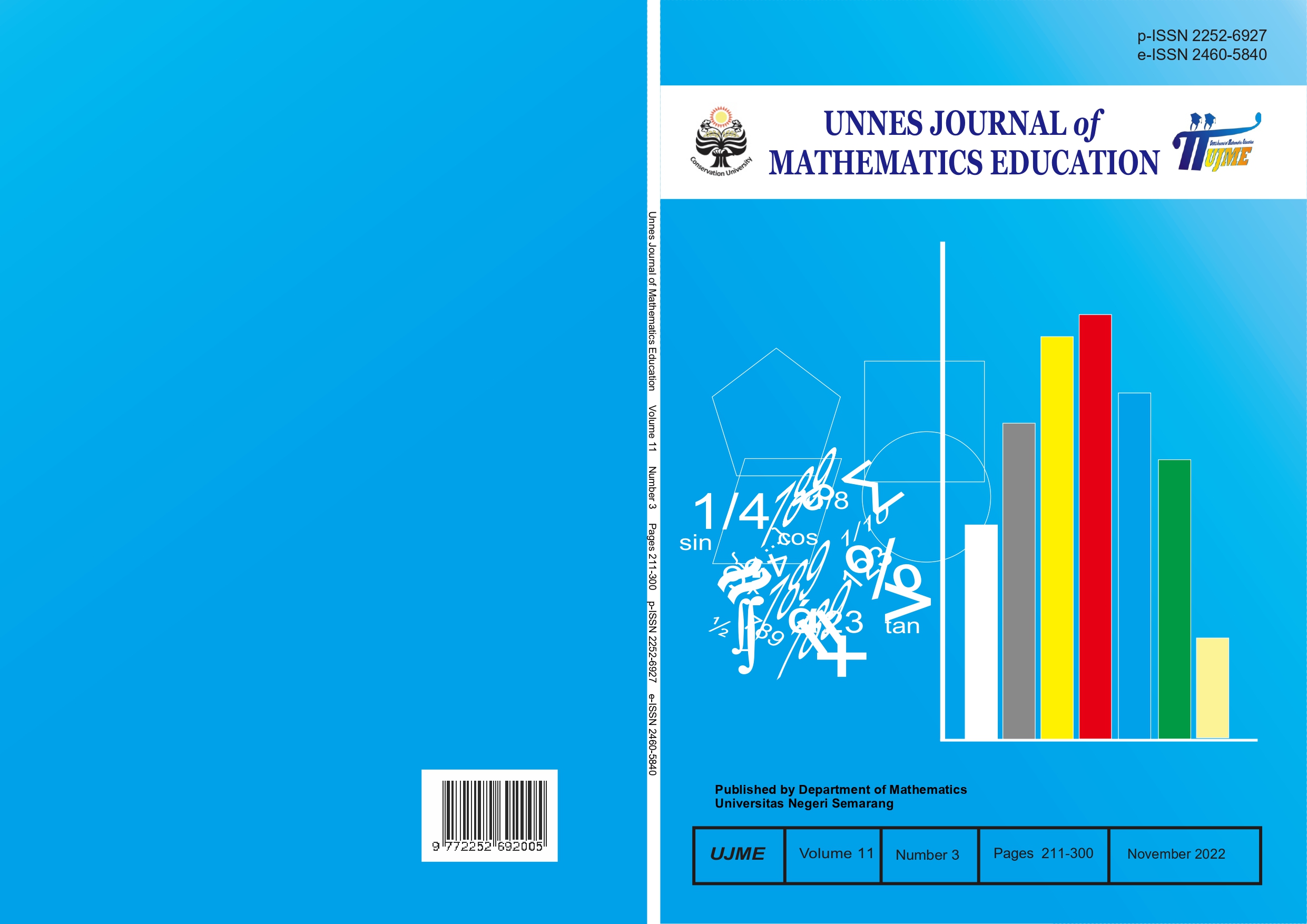Development of Hypercontent-Based Probability Teaching Materials with Problem-Based Learning Model
##plugins.themes.academic_pro.article.main##
Abstract
This research focuses on developing hypercontent-based Probability teaching materials based on problem-based learning models. The purpose of this study was to determine the characteristics, feasibility, and readability of hypercontent-based teaching materials. This type of research is Research and Development (R&D). The procedure used in this research and development adopts the modified Sugiyono (2015) development model, namely (1) potential and problems, (2) data collection, (3) product design, (4) design validation, (5) design revision, (6) product trial, and (7) product revision. This research produces a hypercontent-based Probability teaching material based on a problem-based learning model that has met the suitability of characteristics. The teaching materials were declared valid and suitable for use in learning mathematics with an average feasibility score of 85.82%. Based on the readability test, it was found that the hypercontent-based Probability teaching materials were easy to understand and could be used independently by students with an average readability score of 79.91%.
##plugins.themes.academic_pro.article.details##
References
BSNP. (2008). Bahan Sosialisasi Standar Penilaian Buku Teks Pelajaran TIK.
Cahyani, H., & Setyawati, R. W. (2016). Pentingnya Peningkatan Kemampuan Pemecahan Masalah Melalui PBL untuk Mempersiapkan Generasi Unggul Menghadapi MEA. PRISMA, Prosiding Seminar Nasional Matematika, 151–160.
Carson, J. (2020). A Problem With Problem Solving : Teaching Thinking Without Teaching Knowledge. January 2007.
Fadel, C. (2008). 21st Century Skills: How can you students for the new prepare Global Economy? Nsf Ate, May, 72. http://www.aacc.nche.edu/Resources/aaccprograms/ate/conf2010/Documents/NSF ATE - 21stCS - STEM - Charles Fadel.pdf
Fatin, I., & Yunianti, S. (2019). Kualitas Bahan Ajar Keterbacaan Berorientasi Direct Instruction. Belajar Bahasa, 4(1), 41. https://doi.org/10.32528/bb.v4i1.1866
Hendriana, H., Johanto, T., & Sumarmo, U. (2018). The role of problem-based learning to improve students’ mathematical problem-solving ability and self confidence. Journal on Mathematics Education, 9(2), 291–299.
Hidayat, M. R., & Rusijono. (2020). Pembuatan Animasi 2D Mata Pelajaran Animasi 2D dan 3D Kelas XI Multimedia di SMK MUHAMMADIYAH 2 TAMAN. Jurnal Mahasiswa Teknologi Pendidikan, 10.
Kemendikbud. (2018). Materi Penyegaran Instruktur Kurikulum 2013 Sekolah Menengah Pertama. Jakarta: Kementerian Pendidikan dan Kebudayaan.
Kemendikbud. (2018). Peraturan Menteri Pendidikan dan Kebudayaan Republik Indonesia Nomor 37 Tahun 2018 tentang Perubahan atas Peraturan Menteri Pendidikan dan Kebudayaan Nomor 24 Tahun 2016 tentang Kompetensi Inti dan Kompetensi Dasar Pelajaran pada Kurikulum 2013 pada Pendidikan Dasar dan Menengah. Jakarta: Kemendikbud.
Khulsum, U., Hudiyono, Y., & Sulistyowati, E. D. (2018). Pengembangan Bahan Ajar Menulis Cerpen Dengan Media Storyboard. Diglosia, 1(1), 1–12.
Lidinillah, D. A. M. (2013). Pembelajaran Berbasis Masalah (Problem Based Learning). Jurnal Pendidikan Inovatif, 5(1), 1–7.
Herlina (2019). Pengembangan Bahan Pembelajaran Berbasis Hypercontent pada Pembelajaran Tematik Daerah Tempat Tinggalku. Jurnal Teknologi Pendidikan. 21(1), 73–84.
Mustori, M. (2012). Pengantar Metode Penelitian.
National Council of Teachers of Mathematics ed. (2000). Principles and standards for school mathematics (Vol. 1). National Council of Teachers of Mathematics.
Nurzaelani, M. M., & Septiani, M. (2021). Pengembangan Modul Elektronik Hypercontent Berbasis Higher Order Thinking Skill ( HOTs ). 171–184.
Permana, Y., & Sumarno, U. (2007). Mengembangkan kemampuan penalaran dan koneksi matematik siswa SMA melalui pembelajaran berbasis masalah. Educationist, I(2), 116–123. http://ejournal.sps.upi.edu/index.php/educationist/article/view/59
Prawiradilaga, D. S., Widyaningrum, R., & Ariani, D. (2018). Prinsip-Prinsip Dasar Pengembangan Modul Berpendekatan Hypercontent. Indonesian Journal of Curriculum and Educational Technology Studies, 5(2), 57–65. https://doi.org/10.15294/ijcets.v5i2.17098
Pusat Penilaian Pendidikan Balitbang Kemendikbud. (2018). Laporan Nasional Pisa 2018 Indonesia. Indonesia.
Putra, R. W. Y., & Anggraini, R. (2016). Pengembangan Bahan Ajar Materi Trigonometri Berbantuan Software iMindMap pada Siswa SMA. Al-Jabar : Jurnal Pendidikan Matematika, 7(1), 39–47.
Rosmaini. (2009). Keterbacaan Buku Teks. Artikel Universitas Negeri Medan, 18. http://digilib.unimed.ac.id/420/1/Keterbacaan buku teks.pdf
Sugiyono. (2015). Metode Penelitian Kuantitatif, Kualitatif, dan R&D. Alfabeta. Bandung.
Sukirno, S., & Pratama, R. R. (2018). Pengembangan Model Pembelajaran Atletik Berbasis Permainan Di Sekolah Dasar. Altius: Jurnal Ilmu Olahraga Dan Kesehatan, 7(2).
Yanti, N. D. et. al. (2021). Hubungan Penggunaan Gadget Terhadap Perubahan Perilaku Remaja. REAL in Nursing Journal ( RNJ ). 4(3).
Zaini, M., & Soenarto, S. (2019). Persepsi Orangtua Terhadap Hadirnya Era Teknologi Digital di Kalangan Anak Usia Dini. Jurnal Obsesi : Jurnal Pendidikan Anak Usia Dini, 3(1), 254. https://doi.org/10.31004/obsesi.v3i1.127
